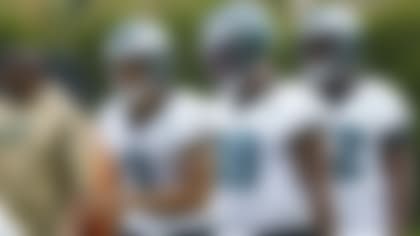Why provide instant grades on the selections of prospects who have yet to take an NFL snap? Well, you're reading this, aren't you? Considering the makeup of every roster and the factors surrounding each pick, Eric Edholm executes a division-by-division assessment of the 2023 NFL Draft. Keep in mind that these grades are based on draft hauls alone -- picks traded for veteran players were not taken into account. Below is the NFC North report card.
Round 1
- Tennessee OT Darnell Wright (No. 10 overall)
Round 2
- Florida DT Gervon Dexter Sr. (No. 53)
- Miami CB Tyrique Stevenson (No. 56)
Round 3
- South Carolina DT Zacch Pickens (No. 64)
Round 4
- Texas RB Roschon Johnson (No. 115)
- Cincinnati WR Tyler Scott (No. 133)
Round 5
- Oregon LB Noah Sewell (No. 148)
- Minnesota CB Terell Smith (No. 165)
Round 7
- Kennesaw State DT Travis Bell (No. 218)
- Stanford S Kendall Williamson (No. 258)
After trading down from No. 1 to No. 9, the Bears narrowed their focus to a handful of top prospects. In the end, they felt better about sliding back one more spot and inherently choosing Darnell Wright over Georgia DT Jalen Carter, a move that will be closely analyzed in the coming years. Wright wasn't universally beloved by scouts, but some felt he could be the best tackle in this class if he improves his technique and consistently plays up to his ability. He should start immediately at right tackle. Chicago's biggest need was arguably defensive line, and the team doubled up on Day 2 with Gervon Dexter Sr. and Zacch Pickens. Wisconsin's Keeanu Benton, who went four picks before Dexter, was a better option, but there's promise in this duo -- or trio, if you believe in seventh-rounder Travis Bell. Dexter hasn't put it all together, but his rare length and surprising burst give him a chance. Pickens likewise hasn't produced at an elite rate but possesses some untapped upside and should be a decent gap shooter. Tyrique Stevenson was a personal favorite, even in a loaded CB class, and looks like a strong fit in Matt Eberflus' zone-heavy scheme, bringing feistiness and toughness. Stevenson could start as a rookie opposite Jaylon Johnson. Fourth-rounders Tyler Scott and Roschon Johnson are two other personal favorites. The Bears wanted another home-run threat, and Scott provides that with plus speed, having averaged nearly 45 yards per college TD reception. Johnson has four-down ability -- he's an excellent special-teamer -- and might actually be a better fit for a gap-run scheme than Khalil Herbert. The final four selections came on defense, adding depth to a unit that ranked dead last in points allowed. Of those, Noah Sewell and Terell Smith intrigue me most. Sewell might be a first- and second-down defender only, but he offers good stopping power vs. the run. Smith has the traits to make it here, but he must be more consistent overall.
Round 1
- Alabama RB Jahmyr Gibbs (No. 12 overall)
- Iowa LB Jack Campbell (No. 18)
Round 2
- Iowa TE Sam LaPorta (No. 34)
- Alabama DB Brian Branch (No. 45)
Round 3
- Tennessee QB Hendon Hooker (No. 68)
- Western Kentucky DT Brodric Martin (No. 96)
Round 5
- William & Mary OG Colby Sorsdal (No. 152)
Round 7
- North Carolina WR Antoine Green (No. 219)
There is a fair and reasonable argument to be had about positional value in the draft. Detroit's approach appeared to fly in the face of modern convention, with the Lions taking a 199-pound running back (Jahmyr Gibbs) and an off-ball linebacker who I thought would be a mid second-rounder (Jack Campbell) in the draft's first 18 selections. They sought out players who fit them as opposed to being beholden to a league-value board. Whatever your philosophy is on this, it's hard to argue Detroit wasn't better by the end of Round 1. Gibbs could be a superior playmaker to D'Andre Swift (who was traded to Philadelphia on Day 3 of the draft), impacting the game as a runner, receiver and returner. The Lions know they'll need his juice with Jameson Williams suspended for the first six games of next season. Campbell figures to start alongside Alex Anzalone, despite Malcolm Rodriguez showing promise as a rookie. The 6-foot-5, 249-pound 'backer tested quite well at the NFL Scouting Combine and has the ability to defend the run and pass (particularly as a zone dropper). The next two picks, Sam LaPorta and Brian Branch, could also start or contribute heavily in Year 1. LaPorta, who has a spirited play style, gives the Lions the quality receiving option at tight end they've lacked since trading T.J. Hockenson to Minnesota. The smart, versatile Branch could wear a lot of hats in the secondary, freeing up Detroit to move C.J. Gardner-Johnson all over the field. The Lions were always a team Hendon Hooker made sense for, and Round 2 would have been a reasonable time to pull the trigger, so getting him a round later to groom behind Jared Goff was a smart play. Hooker has some challenges to overcome to become a starter, but the tools are all there. The Lions' final three picks felt like traits-based reaches at need positions. Brodric Martin wasn't my favorite defensive tackle, but he moves pretty well for his mass and can stop the run. Colby Sorsdal might just have the length to be groomed as a swing tackle. Despite being a 46-game starter at William & Mary, though, he has only played the right side. Antoine Green has decent length and vertical speed, but looks more like a practice-squad candidate to start.
Round 1
- Iowa edge Lukas Van Ness (No. 13 overall)
Round 2
- Oregon State TE Luke Musgrave (No. 42)
- Michigan State WR Jayden Reed (No. 50)
Round 3
- South Dakota State TE Tucker Kraft (No. 78)
Round 4
- Auburn DT Colby Wooden (No. 116)
Round 5
- Penn State QB Sean Clifford (No. 149)
- Virginia WR Dontayvion Wicks (No. 159)
Round 6
- Bowling Green DT Karl Brooks (No. 179)
- Auburn K Anders Carlson (No. 207)
Round 7
- Kentucky CB Carrington Valentine (No. 232)
- Central Michigan RB Lew Nichols III (No. 235)
- Iowa State S Anthony Johnson Jr. (No. 242)
- Charlotte WR Grant DuBose (No. 256)
The Packers made 13 selections, and clearly not all of them will make the opening 53-man roster. But the team's overall approach appeared solid, thoughtful and mostly smart, even if Green Bay is always good for a head-scratcher or two every year. Lukas Van Ness could follow the Rashan Gary development plan and be more of an impact defender in future years than as a rookie in 2023. But with Gary currently rehabbing a torn ACL, LVN's inside-outside versatility and grown-man power should give him a real chance to crack the lineup early. I'm not sure he's a star in the making, but he absolutely can become a Preston Smith-caliber contributor in time. Doubling up at tight end, with Luke Musgrave in Round 2 and Tucker Kraft in Round 3, was a fascinating approach and could open up far more 12 personnel possibilities than the Packers have had in a few years. It's a tad surprising they took two similarly built tight ends with overlapping skill sets, but the duo could allow Green Bay to tinker with alignments and put opposing defenses in a bind with their own personnel decisions. The Jayden Reed pick in Round 2 also took me by surprise, given that he doesn't meet typical Green Bay WR benchmarks. Still, he can be a quality return man and slot who gives you excellent YAC. Colby Wooden and Karl Brooks look like 5-technique candidates. You'd like to see Wooden add a little bulk; Brooks' biggest question at that spot is with his lack of length. Following the Reed outlier, the Packers took two more typecast receivers in Dontayvion Wicks and Grant DuBose, who have the length and enough vertical ability to provide depth outside. Round 7 was a pretty fruitful haul, with Green Bay landing Carrington Valentine, Lew Nichols III, Anthony Johnson Jr. and DuBose. Keep an eye on Johnson, who has CB experience and could make the roster if the Packers aren't shopping for a veteran safety. The two most interesting Day 3 picks were Sean Clifford and Anders Carlson. Clifford never looked like an NFL quarterback to me, but he did beat out Will Levis at Penn State and has the intangibles sought in a QB3. Carlson's arrival doesn't necessarily spell the end of Mason Crosby's run, but that's looking like a real possibility now.
Round 1
- USC WR Jordan Addison (No. 23 overall)
Round 3
- USC CB Mekhi Blackmon (No. 102)
Round 4
- LSU DB Jay Ward (No. 134)
Round 5
- LSU DT Jaquelin Roy (No. 141)
- BYU QB Jaren Hall (No. 164)
Round 7
- UAB RB DeWayne McBride (No. 222)
The Vikings pulled a minor surprise -- but hardly a shock -- when they took Jordan Addison in Round 1. What made it most interesting was doing so with Maryland CB Deonte Banks still on the board. It's reasonable to think they anticipate second-year CBs Andrew Booth and Akayleb Evans will be healthy enough to contribute, although the Vikes did use their next two picks on the secondary. Addison is a dangerous playmaker who will see clearer paths opposite Justin Jefferson. But can the Pittsburgh/USC product thrive on the outside, or will he be mostly limited to the slot? At 173 pounds, lacking elite speed, Addison must show he can get loose from press-man coverage, but he's a three-level threat with polished route-running skills. Mekhi Blackmon was a reach in my mind, but he certainly fits the mold of a Brian Flores defender, so I'll reserve judgment a bit. He is a bit older, however, at age 24 -- and had some injury issues in college. The Jay Ward pick made a little more sense in that he has safety/slot/outside-corner versatility and is a bit cleaner an evaluation from a health standpoint. Jaquelin Roy is a strong, stout defender with the ability to contribute in a rotation, but his lack of twitch likely keeps him off the field in obvious passing situations. The Vikings were expected to be in on the quarterbacks, so the Jaren Hall selection wasn't surprising. He also operated in a system with some pro concepts and has the smarts, moxie and athleticism to make it. But Hall is already 25 years old, injury-prone and lacks high-end arm talent. So, while Kirk Cousins is in the last year of his contract, Hall doesn't exactly present a clear succession plan. Minnesota's final pick was by far my favorite, considering where the Vikings got DeWayne McBride. He absolutely has the tackle-breaking skill and surprising wiggle to be a first- and second-down standout, even while it's obvious his ball security (nine fumbles on 525 carries at UAB) and third-down ability (five catches on 10 targets in 30 career games) are well below average.
Follow on Twitter.
















